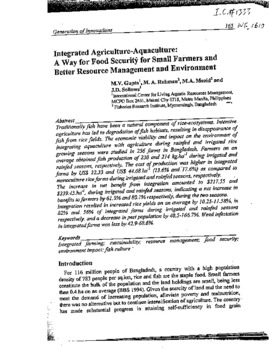Integrated agriculture-aquaculture: a way for food security for small farmers and better resource management and environment

Citation
Gupta, M.V. et al. (1997). Integrated agriculture-aquaculture: a way for food security for small farmers and better resource management and environment. Food security and innovations: successes and lessons learned; international symposium 1996
Traditionally fish have been a natural component of rice-ecosystems. Intensive agriculture has led to degradation offish habitats, resulting in disappearance of fish from rice fields. The economic viability and impact on the environment of integrating aquaculture with agriculture during rainfed and irrigated rice growing seasons were studied in 256 farms in Bangladesh. Farmers on an average obtained fish production of 230 and 214 kg ha-1 during irrigated and rainfed seasons, respectively. The cost of production was higher in integrated farms by US$ 22.33 and US$ 44.68 ha-1 (13.6% and.17.6%) .as compared to monoculture rice farms durihg irrigated and rainfed seasons, respectively. The increase in net benefit from integration amounted to $217.55 and $239.45.ha-1 , during irrigated and rainfed seasons, indicating a net increase in benefits to farmers by 61.3% and 80.1% respectively, during the two seasons. Integration resulted in increased rice yields on an average by 10.25-11.58%, in 82% and. 56% of integrated farms during irrigated and rainfed seasons respectively, and a decrease in pest population by 40.5-166.7%. Weed infestation in integrated farms was less by 42.9-68.6%.
Permalink
Date Available
Type
Countries
Research Themes
Language